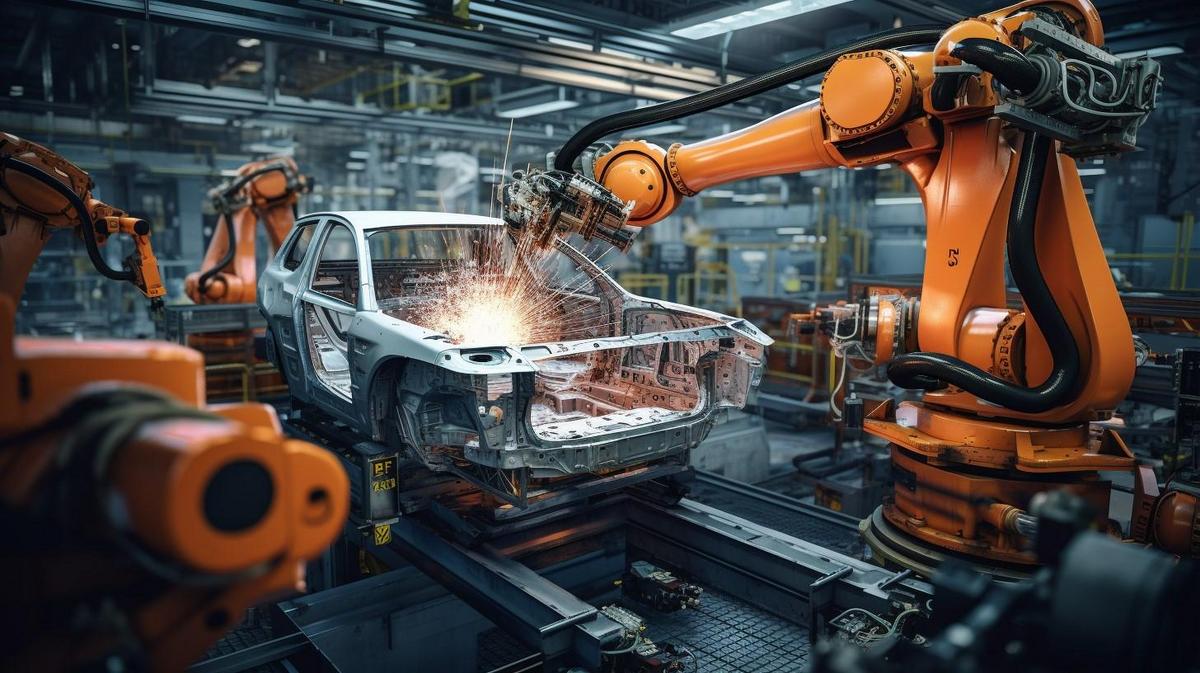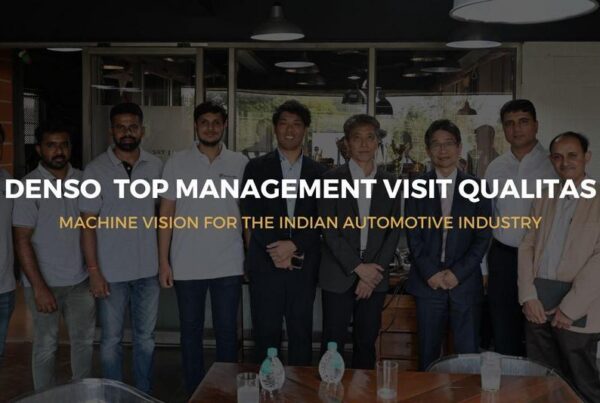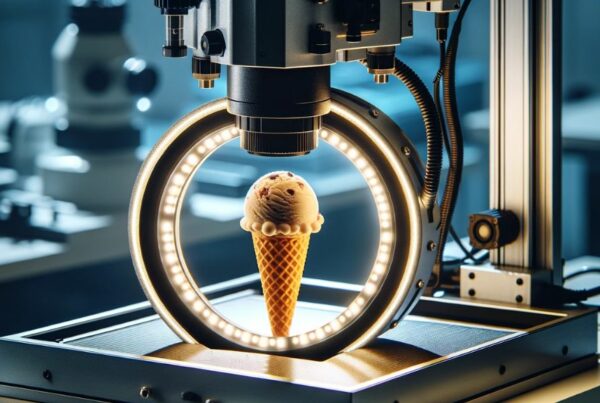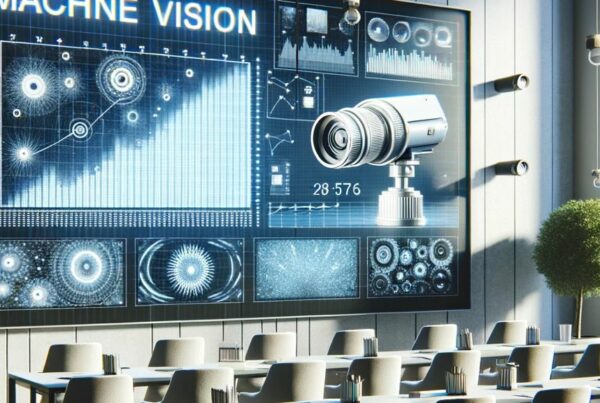
TL;DR:
- Machine Vision systems in manufacturing involve high-end or economical cameras (the hardware) and specific software, which interpret the images captured by the cameras. They are used to make informed decisions based on the visual data gathered.
- Machine Vision applications are diverse, used in quality control in factories, to inspect installations in the automotive industry, for diagnostic imaging in healthcare, and barcode scanning in retail.
- This technology benefits manufacturing processes by ensuring precision, catching defects, improving efficiency and speed, lowering costs and waste, and freeing workers for more complex tasks.
- Currently, Machine Vision is widely used for quality control. In future trends, it is expected to be utilized more in robotics. Major companies like Cognex and KEYENCE lead the Machine Vision market.
- The integration of AI with Machine Vision has revolutionized manufacturing. It enables pattern recognition, object sorting, autonomous decision-making, and drives demand for more efficient systems, leading to market growth. This indicates a promising future for advanced production processes.
Ever wondered how machine vision is revolutionizing the manufacturing landscape? As manufacturing engineers like yourself strive to enhance product quality and manufacturing efficiency, machine vision emerges as a vital tool. But do you know what exactly it entails? Or how far its potential reaches? Say goodbye to uncertainty. This post takes you through the inside outs of machine vision, its applications, benefits, trends, and even how AI is upgrading it. Buckle up for a deep dive into the intricate world of machine vision.
What Constitutes a Machine Vision System in Manufacturing?
“Machine vision” is a term you might have heard. In manufacturing, it’s vital. Picture a robot. It uses special cameras and software to see. The system can then make smart decisions based on what it sees.
A machine vision system has key parts. First, high-end or economical machine vision cameras. These cameras are the eyes of the system.
Next, you have specific software. This machine vision software makes sense of what the cameras see. Without it, the images would be a jumbled mess.
To answer your second question, we can look at a common use of a machine vision system. For example, a camera on a production line could inspect candies. It checks color, size, and shape. If a candy fails its test, the system kicks it out of the line.
So as you can see, machine vision in manufacturing means two things. It’s both the hardware – the cameras and the sensors. And it’s the software that turns images into useful data. It’s also how all these parts come together to form a useful tool. It’s a camera that sees, a system that understands, and the action that follows.
And while we talk a lot about high-end cameras, economical cameras have their place too. For smaller tasks or smaller budgets, they can be just what’s needed. While they may lack a few features, they can perform many of the same tasks as their high-end counterparts.
This ends up creating a system that is flexible, powerful, and affordable. Machine vision, in summary, gives machines the gift of sight. And in the hands of skilled workers, it sure can transform manufacturing.
What are the Applications and Uses of Machine Vision?
Let’s dive into the world of machine vision! This powerful tool is a game-changer in many industries. One might ask, “What are the machine vision applications?” Well, it’s quite diverse!
Picture this: a factory with a complex conveyor system. Machine vision cameras are set up at various points. These cameras are not just your everyday cameras; they are high-end, and designed to capture detailed images. They play a critical role in quality control, detecting any defects in products.
But, machine vision isn’t confined to the factory floor. It’s been making waves in the automotive industry too. Now you may think, “What are the applications of machine vision in the automotive industry?”
Imagine a car assembly line. Machine vision is employed to inspect the installation and fitment of parts, reducing errors and rework. It ensures precision that human inspection may miss, enhancing efficiency and quality.
Machine vision applications are more than just industrial. They’re found in areas like healthcare for diagnostic imaging and retail for barcode scanning.
Machine vision has a broad range of use cases, making it an essential tool in various sectors. Its versatility is indeed remarkable. As technology advances, we can only expect its application to increase and become more refined. It’s safe to say, machine vision is shaping the future of manufacturing.
How Does Machine Vision Benefit Manufacturing Processes?
Machine vision reels in big perks for manufacturing. Imagine zero defects and a safety boost. Sounds dreamy, right? But, hold on, it’s more than just a dream. How so?
Machine vision checks items for quality with precision. It finds defects on the tiniest scale. Say goodbye to recalls and consumer fuss. Your reputation stays clean! You also free workers from tedious inspection tasks. Let them take on more challenging roles.
Now, you’re tired of slow manual checks. Does machine vision operate at lightning speed? Absolutely! Machine vision works fast. It inspects a galaxy of items in a snap. Your outputs skyrocket without more working hours. It’s like magic minus the wand.
Is machine vision a big cost-slapper? Good news! It’s a one-time investment. Say a warm hello to lower costs in the long haul. You get great returns. Let’s not forget less waste and recalls. So, it’s a win for your pocket and Mother Nature!
In conclusion, machine vision is game-changing. It slots in well with manufacturing. Higher quality, speed, and cost savings. All these perks are waiting in line when machine vision steps in.
Current and Future Trends in the Machine Vision Market?
Just how big is the machine vision in the manufacturing market? It’s vast and still growing. With trends in recent years leaning towards more automation, the machine vision market has seen robust growth.
So, what are the current market trends in machine vision? Well, many industries are using it for quality control thanks to its precision and speed. As for the future trends, expect to see more use of machine vision in robots.
Now let’s talk about market share. Analyzing the market share gives us a clear picture of how much of the market is held by key players, offering insight into the competitive landscape. Based on recent data, major companies like Cognex and KEYENCE are leading the way in the machine vision market.
The machine vision market is an evolving one. It is reshaping industries all around the globe and promises an exciting future. This is an excellent time to tap into the potential it offers. Fear not – we’ll be watching the trends for you!
How is AI Transforming Machine Vision in Manufacturing?
The influence of artificial intelligence on machine vision is profound. AI transforms how machines perceive and interact with the physical world. This change in machine vision is thanks to the ability of AI to analyze and interpret visual data more effectively.
AI integrates seamlessly into machine vision systems, boosting their capabilities. This integration allows machines to recognize patterns, sort objects, and make autonomous decisions. These enhanced features benefit a variety of industries, especially manufacturing.
Artificial intelligence revolutionized the vision systems in manufacturing. An example is AI-capable cameras that can work in tandem with robotic arms. In such setups, the robot relies on the vision system to identify defects in products. The machine then sorts or rejects the defective items, improving overall product quality.
AI also impacts the market of machine vision in manufacturing. It does so by driving demand for more efficient and automated systems. With the adoption of AI in machine vision, a surge in market growth is expected. It will reshape the future of the manufacturing sector, bringing about even more advanced production processes. AI’s role in machine vision is pivotal, leading to a transformation in manufacturing that we could only dream about a few years ago. This is just the beginning, and I think we can expect even more exciting advancements shortly.
Conclusion
We dove deep into machine vision systems: their core aspects, real-world applications, and striking benefits in manufacturing. We also charted current market trends and future forecasts. The convergence of AI with machine vision, unclosing exciting potential, was explored. Thinking of embracing machine vision? The perfect time is now. Make the smart switch to improve quality, efficiency, and competitiveness in your production line.





